 |
Raleigh NC (SPX) May 03, 2011 For many practical applications involving lasers, it's important to be able to control the direction of the laser beams. Just ask Han Solo, or the captain of the Death Star. Researchers from North Carolina State University have come up with a very energy-efficient way of steering laser beams that is precise and relatively inexpensive. "In many cases, it is much easier to redirect a laser beam at a target than to steer the laser itself. We intended to develop a way to do this efficiently and without moving anything," says Dr. Michael Escuti, an associate professor of electrical engineering at NC State and co-author of a paper on the research. "We also wanted to be able to steer the beams over a wide range of angles, which is important for practical applications." The key to the Escuti team's success was the use of "polarization gratings," which consist of a thin layer of liquid crystal material on a glass plate. The researchers created a device that allows a laser beam to pass through a stack of these polarization gratings. Researchers manipulated the optical properties of each grating, and were able to steer the laser beams by controlling how each individual grating redirects the light. "Because each individual grating is very good at redirecting light in the desired directions with almost no absorption, the stack of gratings do not significantly weaken the laser power," Escuti says. Another advantage of the system, Escuti explains, is that "every grating that we add to the stack increases the number of steerable angles exponentially. So, not only can we steer lasers efficiently, but we can do it with fewer components in a more compact system. "Compared to other laser steering technologies, this is extremely cost-effective. We're taking advantage of materials and techniques that are already in widespread use in the liquid crystal display sector." The technology has a variety of potential applications. For example, free space communication uses lasers to transfer data between platforms - such as between satellites or between an aircraft and soldiers on the battlefield. This sort of communication relies on accurate and efficient laser-beam steering. Other technologies that could make use of the research include laser weapons and LIDAR, or laser radar, which uses light for optical scanning applications - such as mapping terrain. Escuti's team has already delivered prototypes of the technology to the U.S. Air Force, and is currently engaged in additional research projects to determine the technology's viability for a number of other applications. The paper, "Wide-angle, nonmechanical beam steering with high-throughput utilizing polarization gratings," was co-authored by Escuti; NC State Ph.D. student Jihwan Kim; former NC State Ph.D. student Chulwoo Oh; and Steve Serati of Boulder Nonlinear Systems, Inc. The paper is published in the journal Applied Optics. The research was funded by the U.S. Air Force Research Laboratory. Authors: Jihwan Kim, Chulwoo Oh, Michael J. Escuti, North Carolina State University; Steve Serati, Boulder Nonlinear Systems, Inc.
Share This Article With Planet Earth
Related Links North Carolina State University Space Technology News - Applications and Research
 Europe approves powerful research lasers
Europe approves powerful research lasersBrussels (UPI) Apr 25, 2011 The European Commission says it has approved plans to build new lasers that will dwarf the power of existing lasers for research into particle physics. Three new lasers, each costing about $400 million, will be constructed - one in the Czech Republic, one in Hungary and one in Romania, NewScientist.com reported Monday. The lasers, set for completion in 2015, will be capable of f ... read more |
|
| The content herein, unless otherwise known to be public domain, are Copyright 1995-2010 - SpaceDaily. AFP and UPI Wire Stories are copyright Agence France-Presse and United Press International. ESA Portal Reports are copyright European Space Agency. All NASA sourced material is public domain. Additional copyrights may apply in whole or part to other bona fide parties. Advertising does not imply endorsement,agreement or approval of any opinions, statements or information provided by SpaceDaily on any Web page published or hosted by SpaceDaily. Privacy Statement |